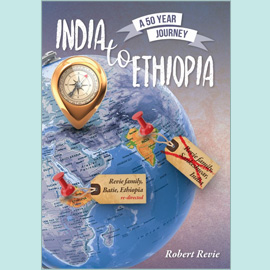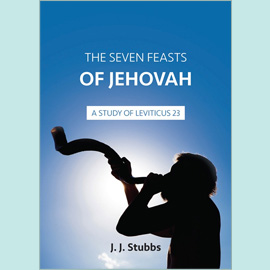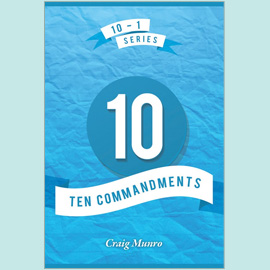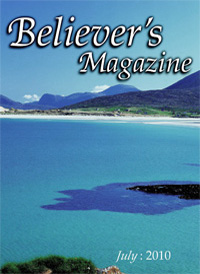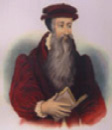
Of all those who promoted the Reformation with its insistence upon the authority of the Scriptures and justification by faith alone, in Scotland no name is better known than that of John Knox. An influential figure with a gift of fiery oratory, it is said that "churchmen and monarchs alike came to resent and fear Knox’s words". He had frequent and hostile encounters with both throughout his public life. A contemporary wrote, "I assure you that the voice of this one man is able in one hour to put more life into us than five hundred trumpets continually blasting in our ears".
John Knox was born around 1510 in or near Haddington, East Lothian. His father, William Knox, a peasant farmer, is said to have fought for Scotland’s king in the battle of Flodden in 1513. His mother died when he was a young boy. After his education near home, he went up to St Andrews University. From 1540 to 1543 he was a churchman in St Andrews, but did not pursue parish duties. He became a tutor to influential families back in his native East Lothian where interest was stirring in the new protestant religion.
At this time, George Wishart, probably the pioneer evangelist of the Scottish Reformation, arrived in East Lothian. Knox became one of his converts and closest associates. He accompanied him abroad in 1544 and in Geneva was influenced by John Calvin and Martin Luther. Knox eventually became Wishart’s bodyguard, carrying a two-handed sword to defend him against assassination threats. When Wishart was arrested in December, 1545, soon after to be burned at the stake in front of St Andrews Castle on the orders of Cardinal Beaton, Knox was prepared to follow him but Wishart said, "Nay, return to your bairns and God bless you. One is sufficient for a sacrifice". This, and his first-hand knowledge of the 1528 martyrdom in St Andrews of Patrick Hamilton, made deep impressions on Knox. His course was set.
After Beaton was killed and St Andrews Castle taken by the reformers, Knox returned there with his young pupils in April, 1547 and became chaplain to the garrison. Soon his powerful preaching was being heard by large congregations in St Andrews, as he proclaimed the authority of the Bible and not the "Church", and salvation by grace through faith. Enthused hearers ransacked the cathedral and smashed statues and images.
Knox’s peace in St Andrews was not to last long. Mary of Guise, the queen regent, enlisted the help of the king of France to retake the castle. On 29th June, 1547, French galleys sailed into the bay, the castle was besieged and surrendered on 31st July. The protestant defenders, including Knox, were taken prisoner, to spend nineteen months as galley slaves, chained to oars, watched over by an officer with a whip in hand. They were threatened with torture if they did not give proper reverence when mass was performed on the ship. Knox recounted an incident in which one Scot (himself?) was required to give a kiss of veneration to a picture of the Virgin Mary. When it was pushed up to his face, he threw it into the sea. After that, according to Knox, the prisoners were no longer forced into such devotions.
In 1548, the galleys returned to Scotland to scout for English ships. Knox was ill with a fever and on the ship they feared for his life. But his mind remained sharp, and focused on hopes of release. While the ships were lying off St Andrews, James Balfour, a fellow prisoner, asked Knox if he recognised the landmark spire of the parish church. He replied that he knew it well, and declared that he would not die until he had preached there again. His words came true.
He was released in February, 1549 and took refuge in England, then more protestant minded. He was given responsibilities in churches in Berwick-on-Tweed, Newcastle, and then in Buckinghamshire. But in 1554, a new queen, Mary Tudor, re-established Roman Catholicism in England and it was no longer safe for protestant preachers such as Knox to remain. He fled through France to Geneva again where he briefly settled, preaching there and in Frankfurt.
He returned to Scotland for a year and with the support of many influential nobles was able to preach openly in Edinburgh in spite of the antagonism of Mary of Guise and her bishops. At this time he married Marjorie Bowes, then went back to Geneva on 13th September, 1556 where his two sons, Nathaniel and Eleazar, were born. He preached and wrote several books and pamphlets, which are renowned for their forthrightness and zeal.
Knox’s next return to Scotland in May, 1559 was to a scene of great turmoil. Political and religious controversy was raging between followers of Mary of Guise and many of the Scottish nobles. Mary declared Knox an outlaw, but he found refuge in Dundee and Perth, and eventually again in St Andrews. On 30th June the reformers occupied Edinburgh, and on 1st July Knox preached from the pulpit of St Giles’ cathedral. Many of his sermons, still accessible in his History of the Reformation in Scotland, clearly declare the way of salvation through faith in Christ alone by the efficacy His blood. On 24th October, the Scottish nobility deposed Mary of Guise from the regency. She died suddenly in Edinburgh Castle on 10th June, 1560, and at last French and English troops withdrew from Scotland. On 19th July Knox led a national Thanksgiving Service at St Giles’.
In August, 1560, the Scottish Parliament accepted the reformed "confession of faith" drawn up by Knox and others. Three acts were passed in one day: to abolish the jurisdiction of the pope in Scotland, to condemn all doctrine and practice contrary to the reformed faith, and to forbid the celebration of mass in Scotland.
A year later, a new queen arrived in Edinburgh, the legendary Mary, Queen of Scots, aged eighteen, whose mother had been her regent in Scotland. Mary had lived her life in France and was a convinced Romanist. She came to face up to the man who was more the leader of her people than she could be.
In his History, Knox records five "conversations" with the queen. They were more rebukes and ultimatums while she flattered and tried to win Knox with tears. In her private chapel she was restoring the mass which Parliament had outlawed, her paramours and adulteries were well known, she married her second husband’s presumed murderer – all of which led to her downfall. After five years in Edinburgh, she abdicated, was imprisoned, and eventually escaped to England, leaving her infant son James as king of Scotland. Knox would see to it that he was brought up as a Protestant.
In December, 1560, Knox’s wife, Marjorie, had died, leaving him to care for their two young sons. In March, 1564, controversially, he married seventeen years old Margaret Stewart, a distant relative of the deposed queen. They had three daughters, Martha, Margaret, and Elizabeth.
The conflict in Scotland continued. Knox chose to leave Edinburgh for St Andrews for a time where he again preached, spoke to students, and worked on his History. At the end of July, 1572, after a truce was called, he returned to Edinburgh, although by this time very feeble and his voice faint. On 9th November he inducted a new minister in St Giles’. His last day on earth was 24th November. With his friends and some of the greatest Scottish nobles around him, he asked his young wife to read to him John 17, "the place where I cast my first anchor"; and Psalm 9, applicable to his lifetime and ours: "The wicked shall be turned into hell, and all the nations that forget God. For the needy shall not alway be forgotten: the expectation of the poor shall not perish for ever. Arise, O Lord; let not man prevail: let the heathen be judged in thy sight. Put them in fear, O Lord: that the nations may know themselves to be but men" (vv.17-20).
He was buried in St Giles’ graveyard, the grave now unmarked and unknown beneath a car park. A large funeral procession followed the body to its last resting-place and heard the new regent of Scotland, James Douglas, Earl of Morton, declare, "Here lyeth a man who in his life never feared the face of man…yet hath ended his dayes in peace and honour".
John Knox claimed in his will, "None have I corrupted, none have I defrauded; merchandise have I not made". The little money he left to his family showed how true this was. His real legacy was the lasting spiritual, moral, and indeed social, changes he pioneered in his native Scotland to the benefit of many generations to come.
